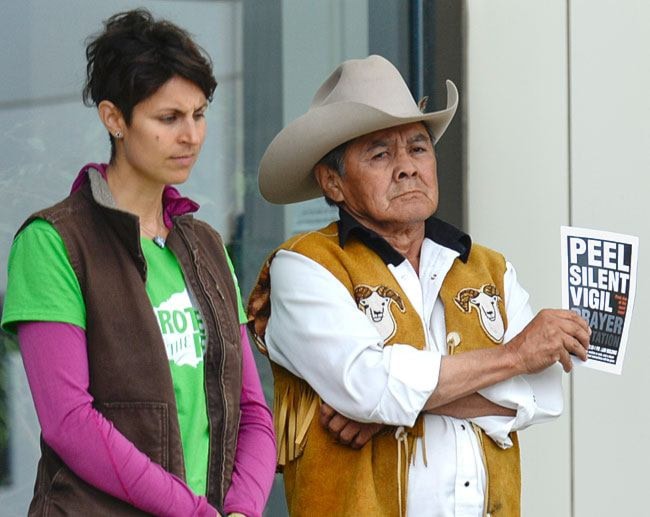The front steps of the Yukon courthouse were buzzing with activity Thursday afternoon as chiefs, officials, members of the public and reporters took in the aftermath of this week’s trial over the fate of the Peel watershed.
Two courtrooms were packed with spectators this week as lawyers argued the limits of Yukon government’s power to decide how much industrial activity will be allowed in the 68,000 square kilometre tract of wilderness in northern Yukon.
The first room filled with elders and chiefs from Dawson City, Mayo and the Gwich’in communities of N.W.T.‘s Mackenzie Delta, as well as bureaucrats and reporters.
Others watched by live feed from a second courtroom, where seats were filled both in front and behind the bench.
The decision is now in the hands of Yukon Supreme Court Justice Ron Veale. He hasn’t indicated when he will deliver a judgement, and onlookers don’t expect to see one until at least September.
Tr’ondek Hwech’in Chief Eddie Taylor said he was overwhelmed by the public interest in the case.
“When we first started out on this process of protecting the Peel watershed, the land use process, never ever did we envision the public support, the overall support that has been shown throughout the last number of years.”
He was pleased in particular to see the faces of so many elders, who travelled from as far away as Inuvik for the proceedings.
“I know you all believe in this cause, and I know you all love that land out there,” said Taylor. “And that’s why we’re here standing up for our rights and your rights.”
That sentiment was echoed by Jimmy Johnny, an elder with the First Nation of Nacho Nyak Dun.
“They more than anybody know the importance of that land and the waters that run through that land,” said Johnny.
He still believes that the Peel should be 100 per cent protected from development, as First Nations have advocated through the planning process, he said.
“I call it my home, because Peel River watershed has taught me a lot about that country. I’ve learned a lot about how to survive and respect that country. I try to keep it clean.”
Just two or three years ago he was doing a caribou survey in the area only to find that some prospectors had left a mess for others to clean up, he said.
“Son of a gun, to my surprise, there was a lot of fuel barrels right in the middle of Bonnet Plume Lake. Just sitting there,” said Johnny.
“You never know what they’re going to do. That’s what bothers me.”
Dave Loeks, former chair of the Peel planning commission, also sat through much of this week’s proceedings.
He said it was rewarding on a personal level to hear Thomas Berger, who represented the plaintiffs in the case, defend the integrity of the commission in light of criticisms brought forward by the government’s lawyer.
John Hunter, counsel for the Yukon government, said that the commission refused to make tough decision and called its plan a “non-planning plan.”
That’s just not true, said Loeks.
The commission “agonized” over how to deal with existing claims, over how access might be granted to the Crest iron deposit in the far reaches of the watershed, he said.
“The commission made some very, very difficult decisions. And I would turn that statement on its head that it’s the government that failed to make difficult decisions in that from year one through year seven they failed to say anything of substance to us.
“By the time the commission has been active for six years and it’s finally getting down to write the recommended plan, we should have a really, really clear understanding of what the bottom-line issues are for all of the parties.
“You can’t expect a public body like a planning commission to be tea leaf readers and wonder what’s on their mind. We assume that they’re going to tell us what’s important to them. And they didn’t.
“They were at the table but they weren’t advising us. That’s bad faith and it’s unfair.”
Tim Gerberding, implementation director with Tr’ondek Hwech’in, had similar comments.
He was a part of the senior liaison committee, a group of high-level officials from First Nations and government charged with monitoring the planning process.
Their job was to “keep the wheels turning,” he said.
“It became clear shortly after the final recommended plan was delivered that the wheels were not turning smoothly.”
In the last couple of years of the process, the committee was pushing its Yukon government representatives to come clean on its position, he said.
“We said look, you know, you’ve got to show us your hand. Where are you coming from? What do you want to see? There’s too much vagueness and generality here. You need to come out of the weeds and show us where you’re coming from here.”
By the time Yukon government introduced its own plans for the Peel, “the sense of collaboration had vanished” between government and First Nations, said Gerberding.
“It was very clear that the government of Yukon was going its own separate way, come hell or high water, heedless of whatever the First Nations might think or propose.”
Contact Jacqueline Ronson at
jronson@yukon-news.com
